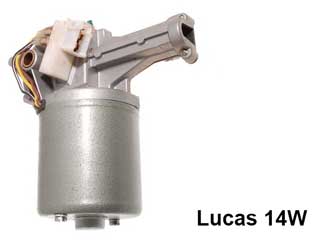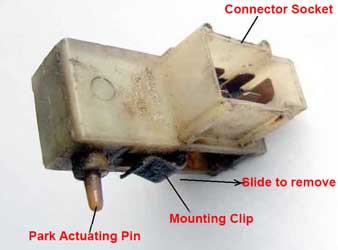

The Windscreen Wiper System
When I installed a new wiper motor and rewired my car I had a problem in that the Park function wouldn't work. In order to be able to figure out what the cause of this was, I had to find out how it all worked! The cause of the problem was that two terminals were not contacting as they should. Below is what I learned.
The GT6 had two types of windscreen wiper systems, the Mk1 had a Lucas DR3A Electromagnetic DC Motor and the Mk2 onwards had a Lucas 14W PMDC (Permanent Magnet DC) motor.


PMDC motors were introduced in the late 1960s as the magnets used became more reliable as they didn't lose their magnetism over time (which they used to), and being simpler were cheaper to produce and could also be made smaller. They are mainly used in automobiles to operate windscreen wipers and washers, to raise and lower the windows, and to drive blowers for heaters and air conditioners. On my GT6 it has 2 speeds, which are achieved by having 3 brushes, therefore there are 3 wires going into the motor, the colours can vary - in my case they were Yellow, Brown and Black/White, unlike the example below!

These wire are connected to a Park Switch which give the system the ability to 'park' the wipers at the bottom of the windscreen. This clips onto the motor (see picture of 14W at the top of this page) and it has 5 terminals which are connected to the Wiper switch on the dashboard. The terminals, which are numbered, are as follows:
| WIPER MOTOR TERMINALS | |
| Terminal | Description |
| 1 | Earth |
| 2 | Park |
| 3 | Fast Speed |
| 4 | Always Live |
| 5 | Normal Speed |
The Park Switch is shown below. The spade terminals can be seen in the connector socket.

The pin protrudes into the body of the motor which has a gear wheel, which generally is not supplied with the motor as it varies in the number of teeth according to the application. They were listed in the angle of sweep, rather than the number of teeth and were available in the range of 95 to 130 degrees of sweep in increments of 5 degrees. For example 100 degrees suited the Spitfire Mk4, Spitfire 1500, and GT6 Mk3 wheras the Spitfire Mk3, and GT6 Mks 1 and 2 needed 130 degrees. Under the gear wheel is a 'cam' which pushes the pin in at every full rotation.

How it works is that when the dashboard switch is in the off position and the pin is not depressed, terminals 2 and 4 are connected and current flows through the dashboard switch to terminal 5 (normal speed). When the cam hits the pin, the connection between terminals 2 and 4 is broken and the motor stops in the 'park' position*. Terminal 4 is described as always live but of course this depends on the ignition being on. When the dashboard switch is in the normal or fast speed positions current flows to the appropriate terminal of the motor and the position of the pin is ignored. A circuit diagram is shown below which hopefully clarifies my previous statements.

*This is really an oversimplication, as some regenerative braking is effected to stop the wipers in the park position. According to the Workshop Manual "A switching feature stops the blades in the park position irrespective of their position when the facia switch is selected OFF. This is effected by a two stage limit switch unit attached to the gearbox. The contacts are actuated by a cam on the final gear. When the facia switch is selected OFF the motor will continue to run until the limit switch first stage contacts open. A momentary period follows during which no contact is made. The second stage contacts then close causing regenerative braking of the armature which maintains consistent parking of the blades".
An excellent video has been produced by Moss-Europe which explains all this far better than I can. To see it click here.
![]()